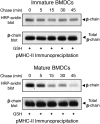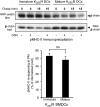Ubiquitination by March-I prevents MHC class II recycling and promotes MHC class II turnover in antigen-presenting cells
- PMID: 26240324
- PMCID: PMC4547296
- DOI: 10.1073/pnas.1507981112
Ubiquitination by March-I prevents MHC class II recycling and promotes MHC class II turnover in antigen-presenting cells
Abstract
MHC class II (MHC-II)-dependent antigen presentation by antigen-presenting cells (APCs) is carefully controlled to achieve specificity of immune responses; the regulated assembly and degradation of antigenic peptide-MHC-II complexes (pMHC-II) is one aspect of such control. In this study, we have examined the role of ubiquitination in regulating pMHC-II biosynthesis, endocytosis, recycling, and turnover in APCs. By using APCs obtained from MHC-II ubiquitination mutant mice, we find that whereas ubiquitination does not affect pMHC-II formation in dendritic cells (DCs), it does promote the subsequent degradation of newly synthesized pMHC-II. Acute activation of DCs or B cells terminates expression of the MHC-II E3 ubiquitin ligase March-I and prevents pMHC-II ubiquitination. Most importantly, this change results in very efficient pMHC-II recycling from the surface of DCs and B cells, thereby preventing targeting of internalized pMHC-II to lysosomes for degradation. Biochemical and functional assays confirmed that pMHC-II turnover is suppressed in MHC-II ubiquitin mutant DCs or by acute activation of wild-type DCs. These studies demonstrate that acute APC activation blocks the ubiquitin-dependent turnover of pMHC-II by promoting efficient pMHC-II recycling and preventing lysosomal targeting of internalized pMHC-II, thereby enhancing pMHC-II stability for efficient antigen presentation to CD4 T cells.
Keywords: MHC class II; March-I; antigen processing and presentation; recycling; ubiquitination.
Conflict of interest statement
The authors declare no conflict of interest.
Figures









References
Publication types
MeSH terms
Substances
Grants and funding
LinkOut - more resources
Full Text Sources
Other Literature Sources
Molecular Biology Databases
Research Materials
Miscellaneous

